The Lean Product Playbook

Реклама. ООО «ЛитРес», ИНН: 7719571260.
Оглавление
Olsen Dan. The Lean Product Playbook
Praise for The Lean Product Playbook
Introduction: Why Products Fail and How Lean Changes the Game
Why Products Fail
Why This Book?
Who Is This Book For?
How This Book Is Organized
Part I. Core Concepts
Chapter 1. Achieving Product-Market Fit with the Lean Product Process
What Is Product-Market Fit?
The Product-Market Fit Pyramid
Quicken: from #47 to #1
The Lean Product Process
Chapter 2. Problem Space versus Solution Space
The Space Pen
Problems Define Markets
The What and the How
Outside-In Product Development
Should You Listen to Customers?
A Tale of Two Apple Features
Using the Solution Space to Discover the Problem Space
Part II. The Lean Product Process
Chapter 3. Determine Your Target Customer (Step 1)
Fishing for Customers
How to Segment Your Target Market
Users versus Buyers
Technology Adoption Life Cycle
Personas
Chapter 4. Identify Underserved Customer Needs (Step 2)
A Customer Need by Any Other Name
Customer Needs Example: TurboTax
Customer Discovery Interviews
Customer Benefit Ladders
Hierarchies of Needs
The Importance versus Satisfaction Framework
Related Frameworks
Visualizing Customer Value
The Kano Model
Putting the Frameworks to Use
Chapter 5. Define Your Value Proposition (Step 3)
Strategy Means Saying “No”
Value Propositions for Search Engines
Not So Cuil
Building Your Product Value Proposition
Skating to Where the Puck Will Be
The Flip Video Camera
Predicting the Future with Value Propositions
Chapter 6. Specify Your Minimum Viable Product (MVP) Feature Set (Step 4)
User Stories: Features with Benefits
Breaking Features Down
Smaller Batch Sizes Are Better
Scoping with Story Points
Using Return on Investment to Prioritize
Deciding on Your MVP Candidate
Chapter 7. Create Your MVP Prototype (Step 5)
What Is (and Isn't) an MVP?
MVP Tests
The Matrix of MVP Tests
Qualitative Marketing MVP Tests
Quantitative Marketing MVP Tests
Qualitative Product MVP Tests
Quantitative Product MVP Tests
Chapter 8
Apply the Principles of Great UX Design
What Makes a Great UX?
The UX Design Iceberg
Conceptual Design
Information Architecture
Interaction Design
Visual Design
Design Principles
Copy Is Also Part of UX Design
The A-Team
UX Is in the Eye of the Beholder
Chapter 9. Test Your MVP with Customers (Step 6)
How Many Customers Should I Test With?
In-Person, Remote, and Unmoderated User Testing
How to Recruit Customers in Your Target Market
User Testing at Intuit
Ramen User Testing
How to Structure the User Test
How to Ask Good Questions
Ask Open versus Closed Questions
I Feel Your Pain
Wrapping Up the User Test
How to Capture and Synthesize User Feedback
Usability versus Product-Market Fit
Chapter 10. Iterate and Pivot to Improve Product-Market Fit
The Build-Measure-Learn Loop
The Hypothesize-Design-Test-Learn Loop
Iterative User Testing
Persevere or Pivot?
Chapter 11. An End-to-End Lean Product Case Study
MarketingReport.com
Step 1: Determine Your Target Customers
Step 2: Identify Underserved Needs
Step 3: Define Your Value Proposition
Step 4: Specify Your MVP Feature Set
Step 5: Create Your MVP Prototype
Step 6: Test Your MVP with Customers
Iterate and Pivot to Improve Product-Market Fit
Reflections
Part III. Building and Optimizing Your Product
Chapter 12. Build Your Product Using Agile Development
Agile Development
Scrum
Kanban
Picking the Right Agile Methodology
Succeeding with Agile
Quality Assurance
Test-Driven Development
Continuous Integration
Continuous Deployment
Chapter 13. Measure Your Key Metrics
Analytics versus Other Learning Methods
Oprah versus Spock
User Interviews
Usability Testing
Surveys
Analytics and A/B Testing
Analytics Frameworks
Identify the Metric That Matters Most
Retention Rate
The Equation of Your Business
Achieving Profitability
Chapter 14. Use Analytics to Optimize Your Product and Business
The Lean Product Analytics Process
A Lean Product Analytics Case Study: Friendster
Optimization with A/B Testing
Chapter 15. Conclusion
Acknowledgments
References
Resources
Tools
Books
People and Blogs
Index
About the Author
WILEY END USER LICENSE AGREEMENT
Отрывок из книги
THE LEAN PRODUCT PLAYBOOK
HOW TO INNOVATE WITH MINIMUM VIABLE PRODUCTS AND RAPID CUSTOMER FEEDBACK
.....
• CEOs and other executives
• People working in companies of any size
.....